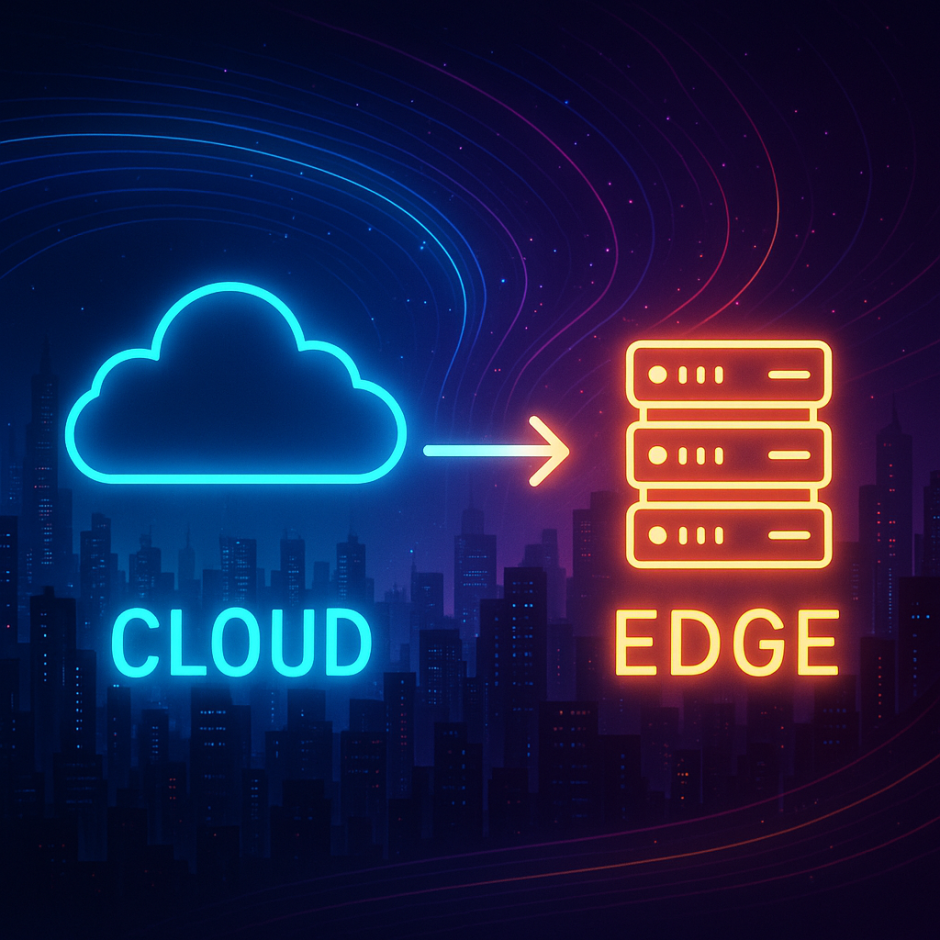From Cloud-Only to Cloud + Edge: A Practical Migration Playbook for IT Leaders
How modern enterprises are cutting latency, reducing cost, improving resiliency—and why the shift is no longer optional.
Introduction: The Cloud Was Never Meant To Do Everything
For 12 years, the dominant IT strategy has been clear: “Move to the cloud.”
But by 2025, almost every CIO and CTO is discovering the same truth:
Cloud-only architectures struggle when users, devices, and data are everywhere.
According to Gartner, more than 55% of enterprise data is now created outside centralized cloud or data-center environments, and by 2027, edge-native workloads will grow 3× faster than cloud-native ones.
Why?
Because modern experiences—payments, fraud detection, IoT alerts, personalization, AR/VR, industrial telemetry—need real-time decisions, not round-trips to distant regions.
A famous example is Walmart’s Black Friday incident in 2019: certain regions saw slower page loads because their cloud region hit sudden traffic spikes. In response, Walmart began deploying regional edge nodes for caching, analytics and rate-limiting, resulting in 30–40% faster page loads the next year.
These shifts created the Cloud + Edge architecture:
Cloud for centralized intelligence. Edge for real-time execution.
1. Why Cloud-Only Starts Failing at Scale
A) Latency isn’t just a number—it’s a business outcome
Every 100ms delay drops conversion by 7–10% in retail.
Every extra second in ATM withdrawal increases customer retry churn.
Every 30ms of lag in fraud signals reduces hit rate by 5–7%.
Cloud round-trips (120–300ms globally) can’t support:
- Real-time scoring
- Biometric authentication
- Interactive experiences
- POS transactions
- Smart camera feeds
- Predictive maintenance on factories
- Safety alerts on construction sites
B) Bandwidth is the silent killer
IoT cameras generate 5–20GB per hour.
Factories produce 1TB/day of telemetry.
Sending everything to the cloud is wasteful and expensive.
C) Compliance & data residency
Countries like:
- France
- Singapore
- UAE
- India
are tightening regulations requiring local processing of customer data.
Cloud regions don’t exist everywhere—but edge nodes can.
D) The cost curve is shifting
What used to be cheap (ingress/egress, storage) is now premium.
Enterprises report 18–40% savings by shifting high-volume read/write workloads to the edge.
2. The Cloud + Edge Architecture (Explained Simply
Think of it like an airline system:
- Cloud = Headquarters
Planning, analytics, AI training, compliance, reporting. - Edge = Airport Terminals
Real-time decisioning, local operations, low latency, resilience.
What runs best on the Cloud?
✔ Data lakes
✔ AI training
✔ Core systems (ERP, HRMS, CRM)
✔ Compliance and long-term storage
What runs best on the Edge?
✔ Caching
✔ Risk scoring
✔ Auth decisions
✔ Local orchestration
✔ IoT filtering
✔ ML inference
✔ Offline-capable apps
3. The Migration Playbook (Your Step-by-Step Guide)
Step 1 — Inventory Your Latency-Critical Workloads
Ask these questions:
- Does the workload require ≤50ms?
- Will latency slow revenue?
- Does failure cause operational impact?
- Do we need offline fallback?
Typical candidates:
- Login flows
- Personalization APIs
- Search, autocomplete
- Fraud scoring
- Transaction validation
- POS + checkout
- IoT sensor processing
- Streaming transformations
Pro tip:
Create a Latency Heatmap across your customer journey.
Red sections = Edge-first targets.
Step 2 — Classify Workloads Across Three Boundaries
| Workload Type | Runs Best | Why |
|---|---|---|
| Global (AI training, analytics) | Cloud | Centralization |
| Regional (compliance, content) | Edge Region | Data residency |
| Local (scoring, IoT, POS) | Device/On-Prem Edge | Ultra-low latency |
This provides a hybrid placement model instead of “everything everywhere.”
Step 3 — Build the Right Edge Layer (Choose Your Pattern)
Pattern A: Lightweight CDNs + Edge Functions
For web & mobile acceleration on platforms like Cloudflare, Akamai, Fastly, AWS CloudFront.
- Best for: authentication, rate limiting, caching, user segmentation
- Latency reduction: 40–60%
Pattern B: Regional Edge Kubernetes
Deploy microservices to regional edge clusters (Equinix, Fly.io, Azure Edge Zones).
- Best for: payments, search, low-latency APIs
- Pros: full-stack compute near customers
- Cons: operational complexity
Pattern C: On-Premise Edge Boxes
Industrial sites, retail stores, quick-service restaurants, hospitals.
- Best for: IoT, ML inference, closed-loop automation
- Example:
McDonald’s uses on-prem edge devices in stores to run AI-driven order-prediction and local menu optimization.
Pattern D: On-Device Edge
Phones, tablets, cameras, EV chargers.
- Best for: vision ML, offline AI, real-time safety
- Example:
Tesla Autopilot processes 90% of decisions on-device, only sending metadata to cloud.
Step 4 — Refactor Services for Edge Readiness
Ask:
Can this service run without persistent cloud connectivity?
Modern edge-ready design requires:
- Stateless or state-light APIs
- Event-driven architecture
- Local-first databases (SQLite/WASM + sync)
- Feature-flagged behavior
- Idempotent operations
- Deterministic fallbacks
Step 5 — Rethink Data Strategy for the Edge World
A) Filter at source
Send events, not raw data.
Example:
A camera with 20GB/hr output → edge ML filters → 200MB/hr → cloud.
B) Regional compliance
Data is processed where it is created. Cloud only receives anonymized aggregates.
C) Eventual sync
Critical in offline-first scenarios (mining, maritime, aviation, rural retail).
4. Security, Governance & Cost Controls in Cloud + Edge
Security Controls
✔ Zero Trust at the edge
✔ Mutual TLS everywhere
✔ Policy-based access (OPA, Kyverno)
✔ Signed releases & remote attestation
✔ Immutable edge configurations
Fun fact:
Visa’s edge network performs tens of thousands of verifications per second using signed policies to prevent fraudulent region spoofing.
Governance Must Mature Too
Edge sprawl can create risk if not managed.
Your governance must track:
- Versioning of edge nodes
- Data flows and residency
- Local logs & forensic access
- AI/ML drift if models run locally
Cost Optimization
Shifting workloads to edge often reduces cloud egress by 30–70%.
Ensure:
- Right-sizing edge clusters
- Autoscaling disabled at the edge (dangerous)
- Local caching for high-volume reads
- Regional subsetting for services
5. Real Example: How a Global Bank Cut Fraud Decision Time by 72%
A Tier-1 bank in APAC faced:
- 250–350ms cloud latency
- High false positives
- Compliance pressure for local processing
They deployed edge fraud scoring nodes in 12 regions.
Results:
- Latency dropped to <80ms
- Fraud detection improved 11%
- Egress costs reduced 40%
- Region-specific compliance met
This is cloud + edge done right.
6. The 30–60–90 Day Roadmap for IT Leaders
0–30 Days
- Build latency heatmap
- Identify edge-ready workloads
- Choose your edge tier (CDN, regional, on-prem)
31–60 Days
- Rewrite 2–3 services to stateless APIs
- Stand up first edge region
- Implement Zero Trust + policy engine
61–90 Days
- Deploy operational dashboards
- Move 5–7% of workload to edge
- Create a Cloud + Edge governance committee
- Launch chaos/resilience tests
7. Common Pitfalls (And How to Avoid Them)
❌ Running your entire backend on edge (expensive, unnecessary)
✔ Move only latency-sensitive workloads
❌ Ignoring observability
✔ Use trace IDs across cloud + edge + devices
❌ Treating edge as “mini cloud”
✔ Edge = deterministic, minimal, secure, purpose-built
❌ Not planning for offline scenarios
✔ Local-first DB + conflict resolution strategy
Closing Thoughts
The Cloud + Edge model is not a trend—it’s the operating system of the next decade.
Companies that adopt edge early will enjoy:
- Faster customer experiences
- Better fraud protection
- Lower infrastructure costs
- Higher uptime
- Stronger compliance
- Real-time personalization
- Safer physical operations
This isn’t a move away from cloud—it’s an upgrade to Cloud + Edge Intelligence.





